MacDougall's Russian Art Auctions 1 December 2011
1 December 2011

* 23. KONCHALOVSKY, PETR (1876-1956)
Landscape. Ravine, signed, also further signed, dated 1927 and numbered "649" on the reverse.
Oil on canvas, 83 by 67.5 cm.
200,000-250,000 GBP
Provenance: Private collection, Europe.
Exhibited: 5th Exhibition of Paintings by P.P. Konchalovsky, Moscow, 1928.
Literature: Konchalovsky. Khudozhestvennoe nasledie, Moscow, Iskusstvo, 1964, p. 168, listed as “zhi 1625”.
Exhibition catalogue, Unknown Konchalovsky, Moscow, The State Pushkin Museum of Fine Arts, 2002, p. 118, visible on a photograph taken at Konchalovsky’s 5th Solo Exhibition.
Konchalovsky organised his fifth solo exhibition in 1928. Held in the foyer of the Moscow Chamber Theatre, he carefully selected only his most recent and most interesting pictures. Among his chosen landscapes — the artist’s preferred genre during the 1920s — was Landscape. Ravine which he had painted the previous summer. Konchalovsky’s decision to show this Central Russian landscape with its genre element, alongside the striking views of the Caucasus which he had brought back from a journey along the Georgian Military Road, attests to the fact that in this painting he had found the solution to a crucial artistic challenge which had been occupying him for much of the 1920s: namely to develop the theme of the human figure in the landscape.
This challenge had also interested Konchalovsky earlier and he had broached it in the Bathers painted at Abramtsevo and later, in his many versions of Woman at a Stream and Nude Against a Verdant Background, of 1928. In Landscape. Ravine however, he rejected the idea of a nude model, preferring his female figure in a contrasting white blouse and blue skirt, whilst trying to achieve a wholeness and consistency to the composition, lest the juxtaposition appear artificial.
As well as issues relating to the structure of landscape, Konchalovsky was at this time especially interested in motifs relating to movement in nature — the wind that bends trees and chases clouds, the light that streams through a curtain of leaves, the colour gradations of aerial planes, the breath of air that fills the space of the landscape. This is why Landscape. Ravine is primarily a landscape in which the genre element plays a notable but not determinant role.
New features appeared in Konchalovsky’s style; a tonal painting system was introduced, an Impressionist dynamic to the brushwork and a desire to convey the illusive space, air, and effect of the sun’s rays. At the same time Konchalovsky retained his passion for intensely resonant colour. It is no coincidence that he executed Landscape. Ravine as a decorative combination of splashes of green, yellow and brown. The landscape is built on a rich array of colour contrasts which lends vigour and vitality to the overgrown stream at the bottom of the gully, the tree-trunks straining upwards, and even nature herself, despite the “wildness”. Konchalovsky successfully ensures that when taking in the image as a whole, the viewer’s gaze does not “stumble” over significant components of the composition (the trees, the sky, the bent figure), instead it registers them as a single living matter. Even in his enthusiasm for pleinairism, the artist does not abandon the physical world, which had been so dear to him, accentuating the materiality, solidity and corporality of the objects depicted.
To give an example, the foliage he has painted forms such a solid mass of colour that there are practically no discontinuities of light in its dense structure and even the patch of sky visible over the gully does not so much create a split in the spatial volume, as facilitate the material expressiveness of the atmosphere.
Sacrificing detail, Konchalovsky uses thick, graphic brushstrokes with such energy and such vigour from the “weightiness” of the subject that it seems as though everything in the landscape is palpitating, the air ripples and undulates and the trees breathe as if human.
Of the natural elements — land, trees, sky — that Konchalovsky drew on in his earlier, Cézannist period, only two remain in Landscape. Ravine: trees and sky. It is pertinent here to quote the words of Cézanne’s friend Émile Bernard, who said of Konchalovsky that he was “the only follower of Cézanne who really understood him and was able to leave in time to move towards Classicism.”
Notes on symbols:
* Indicates 5% Import Duty Charge applies.
Ω Indicates 20% Import Duty Charge applies.
§ Indicates Artist's Resale Right applies.
† Indicates Standard VAT scheme applies, and the rate of 20% VAT will be charged on both hammer price and premium.